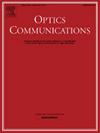通过表面等离子体将高效单光子耦合到单模光纤中
IF 2.2
3区 物理与天体物理
Q2 OPTICS
引用次数: 0
摘要
光量子(单光子)是基于光子的量子计算、传感和通信的基础模块之一。因此,有必要为光子电路中单光子的调谐、引导和耦合开发切实可行的方法,以实现可行的应用。单光子与光纤的相互作用和耦合效率是量子光学的一个技术瓶颈,应通过新颖的设计和材料加以解决。在此,我们介绍了一种基于光纤的微光子设计,可将发射的单光子直接耦合到单模光纤(SMF)的纤芯上。仿真结果表明,单光子源在涂有等离子体薄膜的 D 型 SMF 上发射时,SMF 内的约束表面等离子体会显著放大蒸发场。利用有限元法(FEM)对不同类型和厚度的等离子体材料进行了数值分析,研究了沿 SMF 的传播矢量与单光子源的发射角和波长的函数关系。结果表明,钽层作为新型等离子材料的最佳厚度,可在光纤通信区域(λ ∼ 1550 nm)实现最佳耦合效率。这种方法揭示了新型等离子体辅助耦合,有望成为量子光学各领域单光子操纵的功能性策略。本文章由计算机程序翻译,如有差异,请以英文原文为准。
Highly efficient single photon coupling via surface plasmons into single-mode optical fiber
Quanta of light (single photon) play as one of the building blocks of photonic based quantum computations, sensing, and communications. This makes a necessity to develop practical approaches for tuning, guiding, and coupling of single photons in photonic circuits for viable applications. Interaction and coupling efficiency of single photon into optical fibers is a technical bottleneck of quantum optics and should be addressed by novel design and materials. Here, we introduce a fiber-based micro-photonic design to directly coupling of the emitted single-photon to the core of a single mode fiber (SMF). The results of the simulation indicate that the emission of single photon source on a D-shaped SMF coated by a thin plasmonic film, provide remarkable amplifying of the evanescent field by confined surface plasmons into the SMF. The numerical analysis of different types and thicknesses of plasmonic materials by finite element method (FEM) is conducted to study the propagation vectors along the SMF as a function of the emission angle and wavelength of the single photon source. The results revealed that by the optimum thickness of the tantalum layer as novel plasmonic material, the best record of coupling efficiency can be achieved in the fiber optics communication region (λ ∼ 1550 nm). This approach sheds light on novel plasmonic-assisted coupling and promises a functional strategy for single photon manipulation in various fields of quantum optics.
求助全文
通过发布文献求助,成功后即可免费获取论文全文。
去求助
来源期刊

Optics Communications
物理-光学
CiteScore
5.10
自引率
8.30%
发文量
681
审稿时长
38 days
期刊介绍:
Optics Communications invites original and timely contributions containing new results in various fields of optics and photonics. The journal considers theoretical and experimental research in areas ranging from the fundamental properties of light to technological applications. Topics covered include classical and quantum optics, optical physics and light-matter interactions, lasers, imaging, guided-wave optics and optical information processing. Manuscripts should offer clear evidence of novelty and significance. Papers concentrating on mathematical and computational issues, with limited connection to optics, are not suitable for publication in the Journal. Similarly, small technical advances, or papers concerned only with engineering applications or issues of materials science fall outside the journal scope.
 求助内容:
求助内容: 应助结果提醒方式:
应助结果提醒方式:


